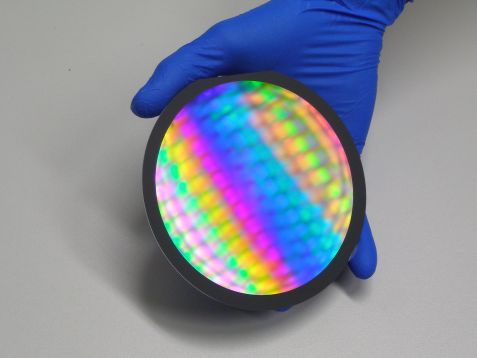MLZ is a cooperation between:
 > Technische Universität München
> Technische Universität München > Helmholtz-Zentrum Hereon
> Helmholtz-Zentrum Hereon
 > Forschungszentrum Jülich
> Forschungszentrum Jülich
MLZ is a member of:
 > LENS
> LENS > ERF-AISBL
> ERF-AISBL
MLZ on social media:

MLZ (eng)
Lichtenbergstr.1
85748 Garching
25.11.2015
Neutrons visualize vortex domains in superconductors

The experimental method of neutron grating interferometry requires three gratings like this made from silicon wafers: One is used as a slit, one as a phase grating to refract the neutron beam, and the third one selects the interference pattern. The three gratings are used at the instrument ANTRARES at FRM II. © T. Reimann / TUM
A novel imaging technique with neutrons allows for the first time to directly image the complex structure of flux tubes within superconductors. Scientists at the physics department of TUM achieved this in a cooperation with the FRM II (TUM) and the Paul Scherrer Institut (Switzerland).
Superconductivity is a state of matter with zero electrical resistance, thus paving the way for interesting applications like carrying electricity without losses. Another defining property of superconductors is the expulsion of magnetic fields: the superconducting phase is characterized by the absence of magnetic or electric fields inside the superconductor. If a magnet is brought towards the superconductor, its magnetic field is simply deflected around it. This behaviour has puzzled physicists for decades, but for the so called type-I superconductors it is meanwhile well described by the Ginzburg-Landau model.
Islands of flux tubes
However, there are other superconductors (called type-II), which still pose some riddles to scientists. Those have a phase (experts call it mixed state), were the magnetic field is not expelled completely, but is trapped in so-called flux tubes, while the remainder of the material remains free of magnetic fields and thus superconductivity preserves. Normally, these flux tubes are distributed evenly among the material. In contrast, the metal Niobium shows an interesting behaviour, bundling these flux tubes into “islands” or domains. The distribution of these form complex patterns, similar to patterns found in different fields of nature.
Scientists at the Paul Scherrer Institut (PSI) and at the Technische Universität München (TUM) are the first to image these structures inside a superconductor. They show which parts of the Niobium sample contain the flux tubes and how their structure changes on increasing the magnetic field. They combined different experiments at the neutron source SINQ of the PSI as well as at the research neutron source Heinz Maier-Leibnitz (FRM II) at TUM, utilizing how neutrons deviate from a straight path on their way through the sample. Neutrons are well suited for these experiments, because they penetrate the sample material — but interact characteristically with the magnetic flux tubes.
At their first experiments the researchers precisely measured the deflection of the neutron beam by the flux tubes and thus determined the size of the domains and the arrangement of the flux tubes within the domains. This method is called small angle neutron scattering, because the neutron’s path only weakly deviates from a straight line. Unfortunately, this method is not suited to determine, whether the domains are distributed homogeneously or whether they are concentrated in certain areas of the sample.
Delicate gratings image structures on the micrometer scale
In order to determine the distribution of the flux tubes the scientists of PSI and TUM employed a new experimental technique called neutron grating interferometry. This utilizes the wave properties of neutrons: the neutrons are diffracted by a series of gratings (thin stripes that are alternatingly transparent or not for neutrons). The first two gratings generate a complex neutron interference pattern. That in turn passes the third grating, resulting in a final interference pattern hitting the detector. The intensity of the final pattern yields information on the size of structures inside the sample. “Grating interferometry allows us to study structure sizes in the range of some micrometers — just about the size of the domains of flux tubes”, explains Christian Grünzweig from the PSI, who was part of the team to develop the method. That means it allows to image the domain structure of the vortex lattice, despite the fact that the isolated domains are smaller than a pixel of the detector (thus they cannot be visualized by conventional means). Surprisingly, it turned out that these isolated domains are formed not at the edges of the sample, but homogeneously inside.
Isolated domain structures as model systems
“The flux vortices of Niobium and their larger structures show typical patterns and structures, which are similar to many different systems in physics or chemistry — occurring on different length and time scales,” explains Tommy Reimann, a PhD student at TUM and lead author of the study. “Some examples are magnetic domains, micro-structures in alloys or some chemical reactions involving diffusion. Changing the magnetic field or the temperature allows us to use the ‘model system’ Niobium in a unique way in order to study the formation of such structures, and hence to derive general conclusions about pattern formation.” The authors of the study emphasize that the experimental technique is well suited to study many other systems that show structures on the micrometer scale.
Translation: Johannes Wiedersich / TUM
Contact:
Tommy Reimann,
Forschungs-Neutronenquelle Heinz Maier-Leibnitz und Physikdepartment E21,
Technische Universität München,
Telefon: +49 89 289 11769;
E-Mail: tommy.reimann@frm2.tum.de
Original Publication:
T. Reimann, S. Mühlbauer, M. Schulz, B. Betz, A. Kaestner, V. Pipich, P. Böni, and C. Grünzweig; Visualizing the morphology of vortex lattice domains in a bulk type-II superconductor; Nature Communications 6, Article number: 8813, doi:10.1038/ncomms9813
MLZ is a cooperation between:
 > Technische Universität München
> Technische Universität München > Helmholtz-Zentrum Hereon
> Helmholtz-Zentrum Hereon
 > Forschungszentrum Jülich
> Forschungszentrum Jülich
MLZ is a member of:
 > LENS
> LENS > ERF-AISBL
> ERF-AISBL
MLZ on social media:


